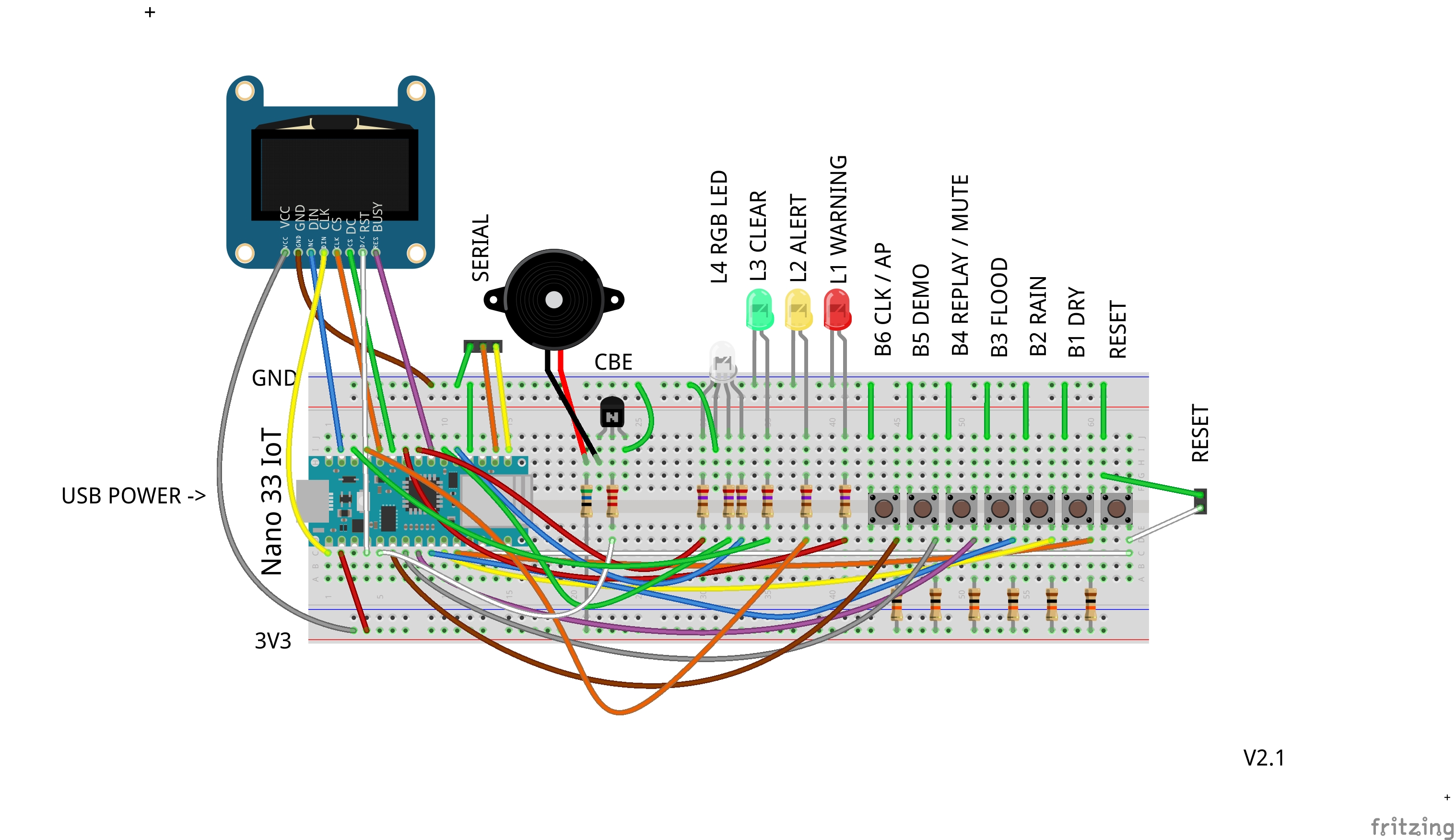Arduino powered flood warning devices
The Environment Agency flood-monitoring API provides developers with access to near real time information covering:
- Flood warnings and flood alerts
- Flood areas which to which warnings or alerts apply
- Measurements of water levels and flows
- Information on the monitoring stations providing those measurements
Water levels and flows are regularly monitored, usually every 15 minutes. However, data is transferred back to the Environment Agency at various frequencies, usually depending on the site and level of flood risk. Transfer of data is typically once or twice per day, but usually increases during times of heightened flood risk.
These APIs are provided as open data under the Open Government Licence with no requirement for registration. If you make use of this data please acknowledge this with the following attribution statement:
"this uses Environment Agency flood and river level data from the real-time data API (Beta)"
This is the easiest way to find out your flood area but there needs to be an alert or warning at the time:
You can get all the flood warnings in the UK in you browser by visiting the following URL: Flood alerts and warnings
Click on the warning you are interested in for example Keswick Campsite: https://check-for-flooding.service.gov.uk/target-area/011FWFNC6KC
The last part of the URL above is the flood warning area code in this example it is 011FWFNC6KC
If there is no flood warning for your area you can find the url from your Lat / Long coordinates. For example Witney in Oxfordshire has lat: 51.7859° N, long: 1.4851° W North is positive, West is negative.
Put these into the following URL
http://environment.data.gov.uk/flood-monitoring/id/floodAreas?lat=y&long=x&dist=d
Where: y is the lat, x is the long and d is the distance in km from your location. Start with close distances and use larger values if you don't get any results.
So for Witney the URL is (Note the negative W coordinate): https://environment.data.gov.uk/flood-monitoring/id/floodAreas?lat=51.7859&long=-1.4851&dist=0.5
Paste this into a browser and you will get a list of possible Flood Areas. Here's the result for Witney:
"items" : [ {
"@id" : "http://environment.data.gov.uk/flood-monitoring/id/floodAreas/061FWF10Witney" ,
"county" : "Oxfordshire" ,
"description" : "River Windrush at Witney and Ducklington down to and including Hardwick" ,
"eaAreaName" : "Thames" ,
"floodWatchArea" : "http://environment.data.gov.uk/flood-monitoring/id/floodAreas/061WAF10Windrush" ,
"fwdCode" : "061FWF10Witney" ,
"label" : "River Windrush at Witney and Ducklington" ,
"lat" : 51.75773 ,
"long" : -1.45314 ,
"notation" : "061FWF10Witney" ,
"polygon" : "http://environment.data.gov.uk/flood-monitoring/id/floodAreas/061FWF10Witney/polygon" ,
"quickDialNumber" : "171073" ,
"riverOrSea" : "River Windrush"
}
, {
"@id" : "http://environment.data.gov.uk/flood-monitoring/id/floodAreas/061WAF10Windrush" ,
"county" : "Gloucestershire, Oxfordshire" ,
"description" : "River Windrush from Bourton to Newbridge including Burford, Asthall, Minster Lovell, Crawley, Witney, Ducklington, Rack End and Standlake" ,
"eaAreaName" : "Thames" ,
"fwdCode" : "061WAF10Windrush" ,
"label" : "River Windrush from Bourton to Newbridge" ,
"lat" : 51.82888 ,
"long" : -1.65351 ,
"notation" : "061WAF10Windrush" ,
"polygon" : "http://environment.data.gov.uk/flood-monitoring/id/floodAreas/061WAF10Windrush/polygon" ,
"quickDialNumber" : "171075" ,
"riverOrSea" : "River Windrush"
}
...
Use the "description" key to find the nearest area to you and then take the "@id" url for that area. For example: "@id" : "http://environment.data.gov.uk/flood-monitoring/id/floodAreas/061FWF10Witney"
Now take the last part of the "@id" url which is the key for that area, in this case "061FWF10Witney"
Copy and paste the key into the magnet_config.h file:
// Your flood area code from Gov.co.uk Flood Warning Service
#define AREA_CODE "061FWF10Witney"
You can test the API for your flood area by making a request in your browser to the following URI: http://environment.data.gov.uk/flood-monitoring/id/floods/{your-flood-area-code}
So in the example above for the Witney use this URI: https://check-for-flooding.service.gov.uk/target-area/061FWF10Witney
This will return a JSON object with all the flood information for that area.
The Falcon / Magnet polls the API at the frequency you set and it receives the API response and displays the following data:
An icon representing the flood warning which may be at one of four possible severity levels - derived from the severityLevel:
Level Name Meaning
- Severe Flood Warning Severe Flooding, Danger to Life.
- Flood Warning Flooding is Expected, Immediate Action Required.
- Flood Alert Flooding is Possible, Be Prepared.
- Warning no Longer in Force The warning is no longer in force
The severity level description - derived from severity
The update date / time - derived from timeRaised (The date and time the warning was last reviewed. Usually (but not always) this leads to a change in the message or severity)
User config is in "falcon_config.h" or "magnet_config.h" Add your WiFi details and Flood Area there.
Audio clips are in ./audio - connect your sound board to your PC and copy the clips to the mounted drive.
Hold down the Demo button and press the Reset button to enter Demo Mode. Press Reset again to exit back to Standard Mode.
